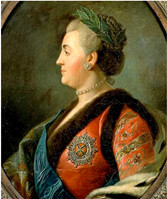
The Governorate reform of 1775
On November 7 (18) 1775 the Empress Catherine II issued the “Constitution for the Administration of Governorates of the Russian Empire”. Under it during 1775-1785 was carried out a major reform of the administrative-territorial division of the Russian Empire. The Governorate reform of 1775 was targeted at consolidation of the power of gentry in order to prevent peasant uprisings.
Until 1775 governorates of the Russian Empire divided into provinces, while provinces were subdivided into districts (Russian: uezd). Under the new decree governorates were now divided only into districts. The main purpose of the reform was adaptation of the new administrative apparatus to fiscal and police matters.
The division was implemented without regard for geographic, national or economic characteristics; it was based merely on a quantitative criteria — the number of population. Under the new decree the population of each governorate ranged between 300 000 - 400 000 men, while the population of a district amounted to 30 000 people.
At the head of the governorate was a governor, who was appointed and removed by a monarch. In his career he relied on a governorate administration, which was formed from a governorate prosecutor and two sotniks. Financial and economic issues were managed by the Treasury Chamber. Schools and charitable institutions were controlled by the Public Charity Office, whose members were elected representatives of estates under the chairmanship of an official. Lawfulness in governorates was guaranteed by a governorate prosecutor and two governorate attorneys.
The executive body in districts was a lower zemstvo court headed by a district police officer, elected by the local gentry. In the chief town of a district the power belonged to an appointed mayor.
Governorate General, who was under the direct supervision of the Empress and the Senate, was assigned to govern over several governorates. Governorate General exercised control over governors of subordinate governorates and regions, supervised the officials, and oversaw the political mood of the estates.
Adoption of the governorate reform of 1775 entirely changed the judicial system. The class principle underlay the system, i.e. for each estate — its own electoral court. Landowners were tried by the Upper zemstvo court in governorates, and a district court in districts; state peasants were tried by the Upper Court (Russian: “rasprava”) in governorates and the Lower Court in the district, citizens were brought to court by a city magistrate in the district and a governorate magistrate in the governorate. All these courts were electoral, except for the Lower courts, which were appointed by the governor. The supreme judicial body in the country was a Senate, while in governorates — Criminal and Civil Court chambers. New to Russia was a non-estate court called “sovestny” (form Russian “sovest” - consciousness) based on humanity, which was called to make an end to faction and reconcile the quarreling parties.
The governorate reform resulted into abolishment of collegia, with the exception of the Foreign Affairs, Military and Admiralty collegia. Functions of collegia were delegated to local governorate authorities. In 1775 was abolished Zaporizhian Sich, while most Cossacks were moved to Kuban.
Within the implementation of the 1775 reform were undertaken measures aimed at strengthening the power of the gentry at the central and local levels. For the first time in the Russian legislation appeared a document which specified the activities of the local government and court. The system set up by this reform survived until 1864, whereas the administrative-territorial division remained until 1917.
Lit.: Исаев И. А. История государства и права России. М., 1996. Гл. 26; То же [Электронный ресурс]. URL: http://www.bibliotekar.ru/istoria-prava-rossii/29.htm; История государства и права СССР / под ред. С. А. Покровского. Ч. I. М., 1959. Гл. 7; Тархов С. А. Изменения административно-территориального деления России за последние 300 лет // География. 2001. № 15.
Based on the Presidential Library’s materials:
Issued Manifesto on annexation of Courland to the Russian Empire // On this day. 26 April 1795;
Manifesto on the Empire’s General Land Survey promulgated // On this day. 30 September 1765;

